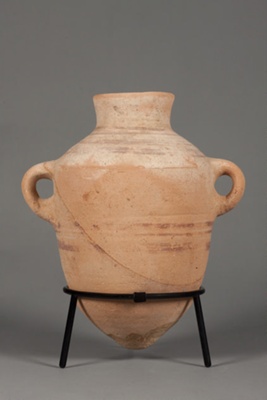< Collection search
< Collection highlights
From:UC Teece Museum of Classical Antiquities
Name/TitleJar
About this objectThis Canaanite jar, or amphora, is made of pinkish-red clay and has the distinctive Canaanite piriform shape (pear-shape) with handles. Canaan was located in the Levant region of present-day Lebanon, Syria, Jordan, and Israel. It was also known as Phoenicia.
This type of jar begins to appear in the Middle Bronze Age, but most surviving examples belong to the Late Bronze Age. The amphora was the primary transport container in the ancient Mediterranean world from the Bronze Age down into medieval times. They were used to convey surplus wine and oil from Canaan to the harbours of New Kingdom Egypt, and from there to ports throughout the eastern Mediterranean. Egyptian reliefs actually detail the process of fermenting wine in sealed Canaanite jars as well as the off-loading of these jars at a custom house in Egypt.
The bottom of this jar has eroded, and there is a diagonal water stain, or 'tide-mark', probably from floating in a tomb. The outer surface and inside the mouth were covered in a cream slip, which has mostly worn away, along with the purplish-red decorative bands around the mouth, shoulder and below the handles. The handles are rounded and vertical, attached just below the shoulder.
Date Madeca. 1400-1200 BC
PeriodLate Bronze Age
Place MadeMiddle East
Medium and MaterialsCeramic: Pottery
Style and IconographyCanaanite
TechniqueMolding (forming)
MeasurementsHeight 280mm; Diameter ca. 175mm
Named CollectionThe James Logie Memorial Collection, University of Canterbury, New Zealand
Credit LineDonated by M.K. Steven, 1975
Object TypeContainers
Object number159.75
Copyright LicenceAll rights reserved
